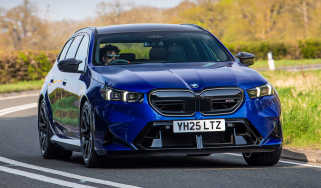Tyre comparison: choosing the right tyres for your car
We compare different tyre types, low tyre tread depths and incorrect tyre pressures to see what different they make to winter safety
Tyres are the only parts of your car in contact with the road - the only things keeping you on the tarmac and out of a hedge, making them crucial to your car's performance and safety. Cold, wet or icy conditions can really make tyres struggle, but plenty of motorists exacerbate the problem further by not putting enough thought into choosing the right tyres. That's why we took an in-depth look at different tyre types in different conditions to help you make the right choices where your car tyres are concerned.
Auto Express teamed up with Goodyear at the MIRA test track to see just how much drivers can benefit from investing in a good-quality set of tyres; or at least keeping the set they currently own well maintained.
To replicate the conditions of wintry British roads, we used MIRA’s one-mile wet handling track, as well as its brake testing facilities – all covered by water sprinklers in constant action – to put our two identical 1.5 TDCi Focuses and five sets of 205/55 R16 tyres through their paces.
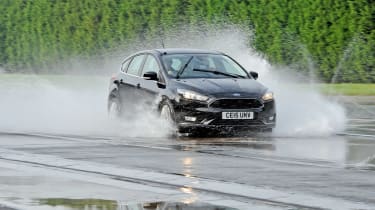
We tested each set of tyres objectively, using braking distances and lap times, as well as subjectively, on the amount of feedback and confidence they translated through the steering wheel and pedals.
Our results should encourage you to double check the condition of your tyres, and think twice before just plumping for the cheapest set available next time you buy...
• Our complete guide to winter tyres
Test 1: new tyre vs part-worn tyre
Around 40 per cent of UK drivers don’t know the minimum legal tread depth (1.6mm), so even fewer are aware of the performance consequences of low tread levels. On MIRA’s wet braking track, we lined up our two Fords with Goodyear’s EfficientGrip Performance tyres. But one set was brand new, with 6mm of tread; the other had just 1.6-2mm of tread.
The wet braking road mimics heavy rain, as it’s under a constant spray of water from the dozen or so sprinklers around the straight. We accelerated to 55mph in each Focus, and on reaching a marker, hit the brakes and measured the stopping distance. On the new tyres, the car came to a halt in 39.6 metres; but that was 10.3 metres sooner on average than the worn set, or roughly two car lengths.
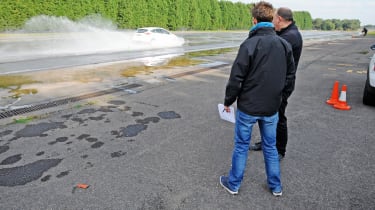
More alarming was the feedback from the tyres. With the worn set, the brakes instantly felt numb, the pedal felt solid, and only after 10 to 15 metres were we able to feel the tyres find grip and slow the car. In contrast, the new set instantly bit into the surface, we could feel the rubber decelerating the car and there was no pedal numbness. Stuart Fane, MIRA expert driving instructor, told us: “That 10-metre delay comes from the worn tyre not dispersing water quickly enough. The tyre is essentially aquaplaning for a moment, which is why the brakes feel numb and the steering too light.
“The fact that the low tread depth disperses water less efficiently doesn’t just mean a longer braking distance, but the initial lack of brake feedback means some drivers may lift off the brake pedal as they think something is wrong. This is where accidents can happen.”
Test 2: Premium winter tyre vs budget winter tyre
The basalt tiles on the braking circuit at MIRA replicate the effects that snow has on tyres, as they mimic its slippery, unpredictable nature, with a very low-grip surface. Winter tyres aren’t just for snow, though; studies have shown they brake and handle better than summer equivalents whenever the temperature falls below seven degrees Celsius.
Yet not all winter rubber is the same. To see just how much winter tyres differ from one another, we equipped one of our Ford test cars with Goodyear’s UltraGrip Performance Gen-1 tyres, while the second was fitted with a set of budget Wanli Snowgrip tyres. The cars were accelerated to 52mph, and when we reached a marker, we braked hard and measured the stopping distances.
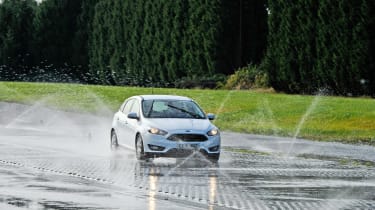
The results were startling. On Goodyear tyres, the car stopped in 94.4 metres on average, outbraking its cheaper rival by over 40 per cent; the Focus averaged 138.3 metres on the Wanli set – or 44 metres more. “Think how many cars, pedestrians and other road users fit in the space of 44 metres,” Stuart said.
Unlike in the wet braking test, the tyres provided similar feedback through the pedal and steering wheel. Each time we hit the brakes, the pedal was heavier than at the wet braking track, and the steering felt surprisingly light. Only with the Goodyear tyres did we notice more steering feedback, but it wasn’t substantially different from the Wanli’s.
Stuart added: “Anyone can press the brake pedal hard, but no matter how good your reactions are, it’s ultimately the tyre that will determine how fast you come to a stop, and the 44-metre difference speaks for itself. This test proves that you get what you pay for with budget tyres.”
Test 3: Correctly inflated tyre vs underinflated tyre
Perhaps the easiest mistake for drivers to make is not to check whether their tyres are correctly inflated. Yet according to our findings, this may just be the most costly mistake of all. We used a set of Goodyear EfficientGrip performance tyres around MIRA’s track, and after a handful of laps we took the pressures down to 18psi and headed out again. The differences were staggering.
Whereas previously our Focus test car felt poised and predictable through the corners, the underinflated tyres hurled the hatchback around with little warning. On underinflated rubber, the car lapped the same 10-corner track seven seconds slower (with an average time of one minute 29.3 seconds) – but then lap times are only half the story.
Nigel explained: “You can just feel the tyres bouncing around the rim. They provide that terrible, soggy feedback which translates to less feel through corners and makes everything unsafe.”

This proved to be the case in the emergency braking test we carried out around one of the corners – the car took longer to stop than it had with the correctly inflated tyres, and nearly ran into a ditch at the side of the track.
“We’ve worsened the transfer of energy through the brakes to the tyres. They communicate terribly with the rest of the car now,” Nigel told us.
It was the right to left chicane that proved most challenging for the low-pressure Goodyears, because the car almost leaped from one corner to the next. The lack of air in the tyres turned the Focus from a well balanced family hatch into a frightening bouncy castle.
Test 4: Premium summer tyre vs budget summer tyre
The one-mile MIRA wet handling track is set up to replicate a typical British A or B-road, with a long straight followed by a right-hand chicane into a right-hand hairpin. We tested a premium tyre – Goodyear’s EfficientGrip Performance – against a set of budget Rockstone F109 tyres. Neither was a specialist winter or all-season tyre, so it’s a good barometer of what many UK drivers will have fitted when out on the roads this winter.
Up first was the Rockstone. The MIRA layout proved too much for our Focus as it began to slide from one corner to the next without any indication. We took on the corners as any normal driver would on a typical A or B-road, not adjusting the steering angle mid-bend, but the F109s struggled to disperse water fast enough, and the front end unexpectedly lost grip. “When the front snaps, most drivers would release the throttle and cause lift-off oversteer, further driving the car to the opposite lane,” said Nigel.
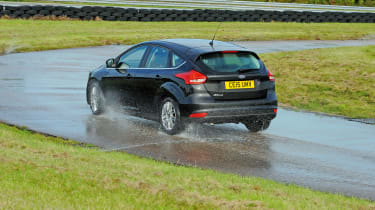
The budget tyres fared just as poorly in the emergency braking test around one of the corners, and would have sent our Ford into a ditch had we kept the steering angle constant. “This shouldn’t happen,” concluded Nigel. “A good set of tyres would have halted the car in its tracks.”
Conversely, the Goodyear proved more stable and predictable in all the corners the Rockstones had struggled with. Plus, the premium set delivered on the most crucial part of winter driving: confidence. We were able to tell exactly when the tyre began to lose grip, and slow the car.
“This is how you can tell it’s a far better tyre,” Nigel said. “It provides so much more feedback, making you a more confident driver.” Of course, for maximum confidence, a winter tyre will provide even more reassurance.
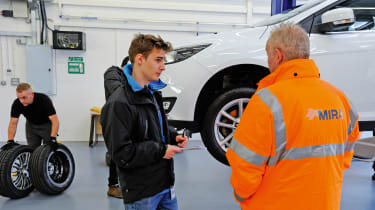
Tyre comparison: our verdict
Numbers and measures usually decide tyre tests, but our comparison tests here highlight that these numbers often determine the outcomes of the kind of situations drivers face every day. It’s never a question of if a driver will have to make an emergency stop in their lifetime; it’s a question of when. And on that day, other road users shouldn’t have to second guess whether you have enough air or tread left in your tyres.
If our findings have made you think about changing the tyres on your car, and switching to a new set of winter tyres or all-season versions, we recommend having a look at the winners of our respective 2015 tests.
Our pick of the best car tyres on sale now
2016 winter tyre test winner: Continental WinterContact TS 860
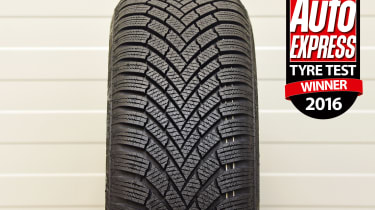
Such is the focused performance of the Continental WinterContact TS 860 that you could almost be justified in calling it an all-season tyre. It will keep you safe on snow, and then it will excel in the wet and on dry roads – exactly the conditions UK drivers will face for much of the winter.
Price: £91.13 for 225/55 R16 size from Black Circles (www.blackcircles.com)
Read the full Auto Express winter tyre test here...
2016 all-season tyre test winner: Goodyear Vector 4Seasons Gen-2
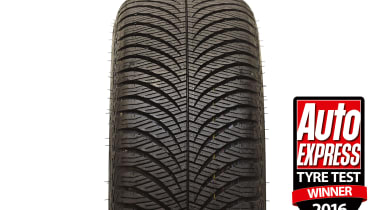
As we saw in our last all-season tyre test, it takes a balanced performance across all our assessments to crown a winner, and that’s what Goodyear has delivered here. There’s no doubt this product is from the winter tyre school of all-season design, but it does enough in the wet and dry tests to take the overall victory.
Price: £113.94 for 205/45 R17 size from Black Circles (www.blackcircles.com)
Read the full Auto Express all-season tyre test here
Winter driving special

Best winter cars
| • Hot new SUVs coming soon | • Best SUVs to buy now |
| • Best crossovers to buy now | • Best small 4x4s to buy now |
Get ready for winter on the roads
Top tips for winter driving
Find a car with the experts


